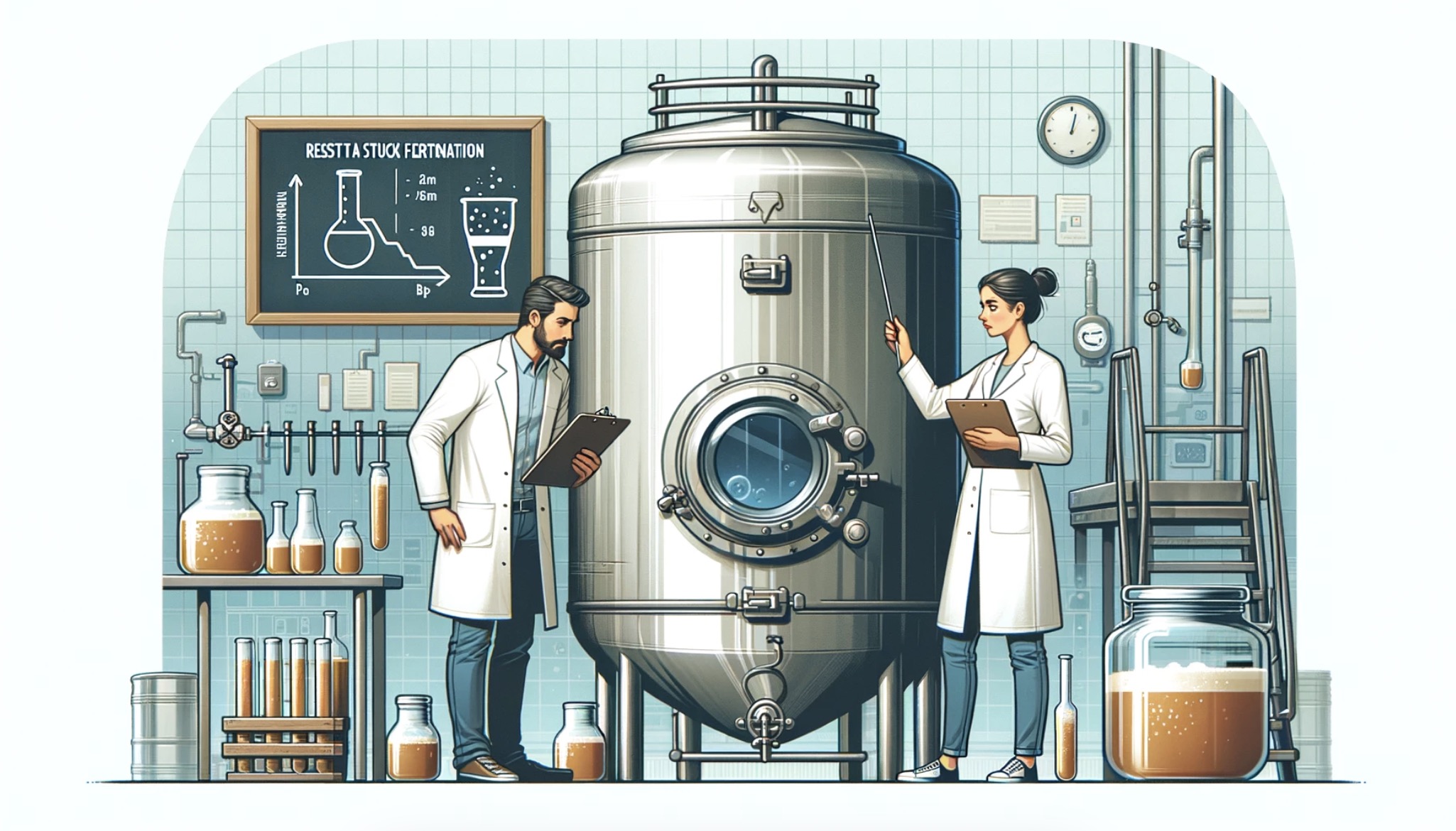Cold fermentation in beer is the process of fermenting beer at lower temperatures, typically between 45-55°F (7-13°C), using lager yeast strains. This method produces a cleaner, crisper taste, and allows for a more delicate balance of flavors in the final product.
As a home brewer, I’m always looking for ways to improve the quality and taste of my beer. One of the most significant factors that can affect the flavor and characteristics of your brew is the fermentation process. Over the years, I’ve experimented with various fermentation techniques, and cold fermentation has become one of my favorite methods for certain styles of beer.
In this blog post, I will share my knowledge and experience with cold fermentation in beer, including its benefits, how to do it, the different types of yeast involved, and some tips for success. If you’re interested in trying this technique in your home brewing endeavors, I hope you find this information helpful.
What is Cold Fermentation?
The Science Behind Cold Fermentation
Cold fermentation is a brewing process that occurs at lower temperatures than traditional ale fermentation, which usually takes place between 60-72°F (15-22°C). When fermenting beer at these lower temperatures, different yeast strains are used – lager yeast strains, to be specific. These strains, belonging to the Saccharomyces pastorianus species, are more tolerant of the cold and actually thrive in these conditions.
At these lower temperatures, the yeast’s metabolic processes slow down, resulting in a longer fermentation time. This extended fermentation time allows for a more complete consumption of the sugars and other compounds in the wort, leading to a cleaner, more refined taste in the finished beer.
Styles of Beer Suited for Cold Fermentation
Cold fermentation is best suited for lager-style beers, which are known for their clean, crisp taste and smooth mouthfeel. Some examples of lager styles that benefit from cold fermentation include:
- Pilsner
- Munich Helles
- Vienna Lager
- Maibock
- Marzen/Oktoberfest
- Baltic Porter
However, some home brewers have also experimented with cold fermentation for other styles, such as hybrid beers (e.g., California Common) and even some ales, to achieve unique flavor profiles.
Benefits of Cold Fermentation
Improved Flavor and Clarity
One of the primary benefits of cold fermentation is the cleaner, crisper taste it imparts to the beer. The slower fermentation process allows the yeast to consume more of the byproducts produced during fermentation, resulting in fewer off-flavors and a more balanced beer. Additionally, cold fermenting helps to clarify the beer, as proteins and other particulates are more likely to settle out at lower temperatures.
Enhanced Malt and Hop Balance
Cold fermentation allows for a more delicate balance between malt and hop flavors, as the yeast doesn’t produce as many esters or phenols that can mask these elements. This is particularly important for styles like Pilsners, where the subtle interplay between malt sweetness and hop bitterness is a key characteristic.
Better Lagering Potential
Since lager yeast strains work best at lower temperatures, cold fermentation is essential for creating authentic lager-style beers. Furthermore, the extended fermentation time allows for a more complete attenuation (consumption of sugars), resulting in a drier and more stable beer that can be stored (lagered) for extended periods without developing off-flavors.
How to Cold Ferment
Equipment and Setup
To successfully cold ferment your beer, you’ll need to be able to maintain a consistent temperature within the ideal range for your chosen yeast strain. This can be achieved using a temperature-controlled fermentation chamber, such as a modified refrigerator or freezer with an external temperature controller.
Yeast Selection
Choose a lager yeast strain that is well-suited for cold fermentation, such as:
- Wyeast 2124 (Bohemian Lager)
- Wyeast 2308 (Munich Lager)
- White Labs WLP830 (German Lager)
- Saflager W-34/70
Each strain has its own ideal temperature range and flavor characteristics, so be sure to consult the manufacturer’s recommendations for best results.
Fermentation Process
Once you have your equipment and yeast set up, follow these steps for a successful cold fermentation:
1. Cool your wort to the recommended temperature for your chosen yeast strain.
2. Pitch the yeast and seal the fermentation chamber.
3. Maintain a consistent temperature within the ideal range for your yeast strain throughout the fermentation process. This may take 2-4 weeks, depending on the strain and temperature.
4. Once fermentation is complete, you can choose to lager (store) your beer at even colder temperatures (around 32-40°F or 0-4°C) for an additional period to further enhance clarity and flavor.
Tips for Success
Proper Yeast Pitching Rates
Cold fermentation requires a healthy yeast population to ensure complete attenuation and minimize off-flavors. Be sure to pitch an appropriate amount of yeast for your batch size and gravity, typically 1.5-2 times the amount you would use for an ale.
Aerate the Wort
Oxygen is crucial for healthy yeast growth, especially at lower temperatures. Be sure to aerate your wort well before pitching the yeast to provide the necessary oxygen for a successful fermentation.
Be Patient
Cold fermentation takes longer than traditional ale fermentation, so be prepared to wait for your beer to reach its full potential. The extra time is worth it for the clean, crisp flavor it imparts.
Conclusion
In conclusion, cold fermentation is a brewing technique that allows for a cleaner, crisper taste and a more delicate balance of flavors in your beer. By fermenting at lower temperatures using lager yeast strains, you can create authentic lager-style beers and even experiment with unique flavor profiles for other styles.
Here are 10 key facts about cold fermentation in beer:
1. Cold fermentation takes place at lower temperatures, typically between 45-55°F (7-13°C).
2. Lager yeast strains are used for cold fermentation, as they thrive in colder environments.
3. Cold fermentation results in a cleaner, crisper taste in the finished beer.
4. Lager-style beers are best suited for cold fermentation.
5. Cold fermentation allows for a more delicate balance between malt and hop flavors.
6. A temperature-controlled fermentation chamber is necessary for maintaining ideal fermentation temperatures.
7. Choose a lager yeast strain with an ideal temperature range and flavor profile for your beer.
8. Proper yeast pitching rates and wort aeration are crucial for successful cold fermentation.
9. Cold fermentation takes longer than traditional ale fermentation, typically 2-4 weeks.
10. The end result is a more refined and enjoyable beer that showcases the art of brewing.
FAQs
How long does it take to cold condition beer?
Cold conditioning time for beer can vary depending on the style of beer and the desired flavor profile. Generally, lagers require longer cold conditioning periods of 4-6 weeks, while ales may only need 1-2 weeks. However, some brewers may choose to cold condition for even longer periods to achieve a smoother, cleaner taste.
Is cold crashing necessary?
Cold crashing is not always necessary, but it can be beneficial for certain types of beer. It can help clarify the beer by causing suspended particles to settle to the bottom, resulting in a clearer and cleaner final product. It can also help improve the beer’s flavor and aroma by reducing the presence of certain compounds that can cause off-flavors. However, some styles of beer benefit from a bit of haze and may not require cold crashing. Ultimately, the decision to cold crash should be based on the desired outcome for the specific beer being brewed.
What is cold brewed beer?
Cold brewed beer is a type of beer that is brewed using cold water instead of hot water, resulting in a smoother and less bitter taste. The process involves steeping the grains in cold water for an extended period of time, usually 12-24 hours, before adding yeast and allowing it to ferment.
What temperature is a cold crash homebrew?
A cold crash homebrew typically involves lowering the temperature of the beer to around 32-40°F for a period of 24-48 hours, depending on the style and desired clarity.
Which beers are cold fermented?
Lagers are typically cold fermented, while ales are typically warm fermented.
How do you cool beer fermentation?
Beer fermentation can be cooled using a variety of methods, such as using a refrigeration unit, a cooling jacket, or a submerged coil. The temperature of the beer during fermentation is critical to the flavor and quality of the final product, and it is typically kept between 60-68°F (15-20°C) for ales and 45-55°F (7-13°C) for lagers.




